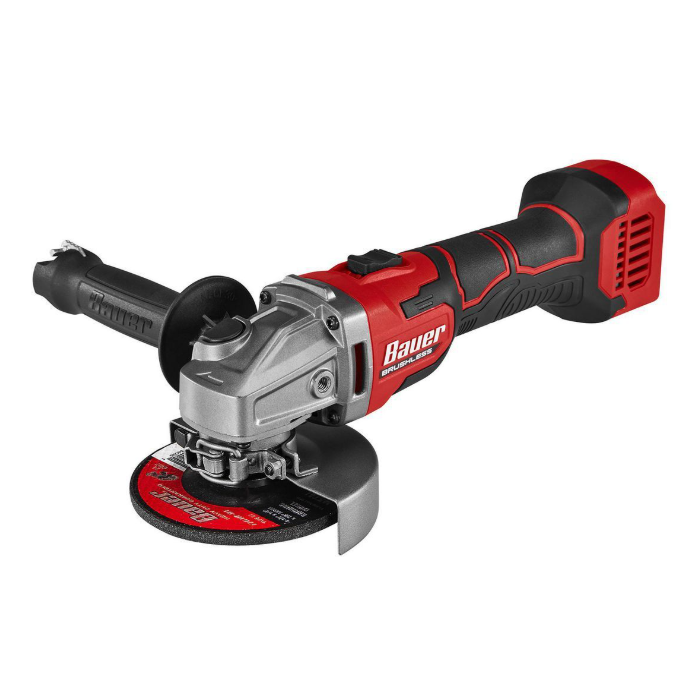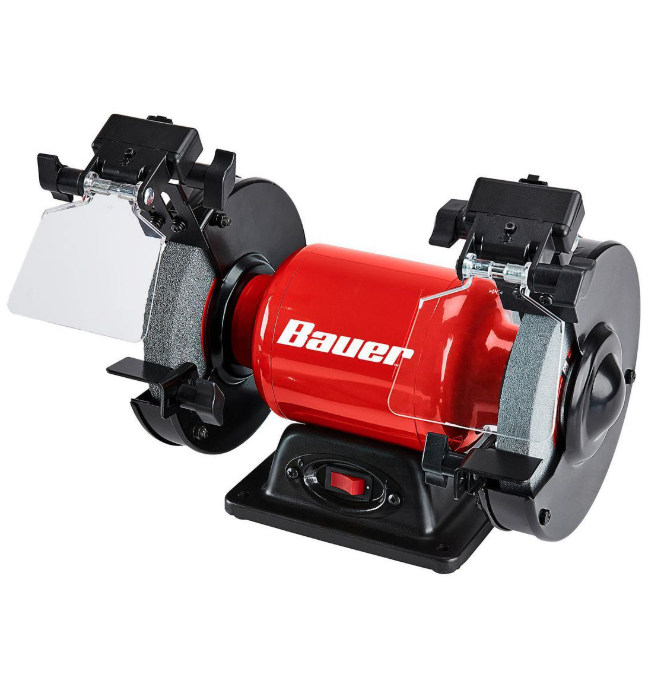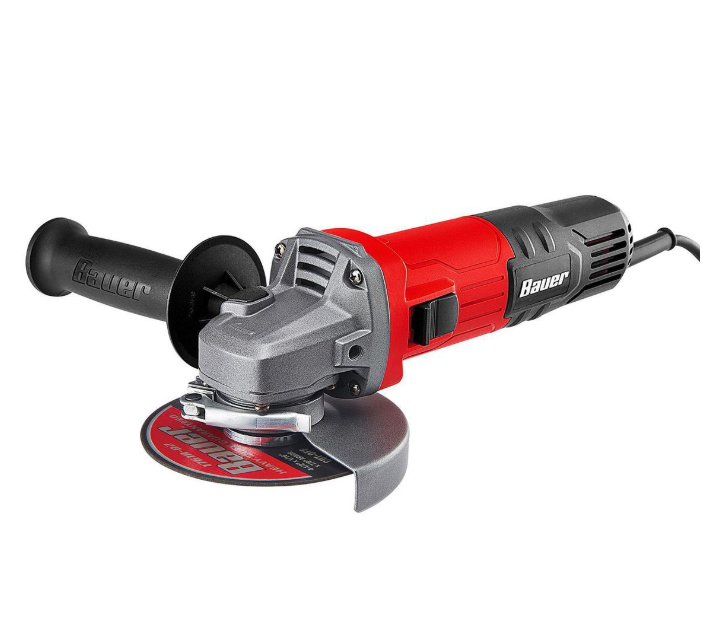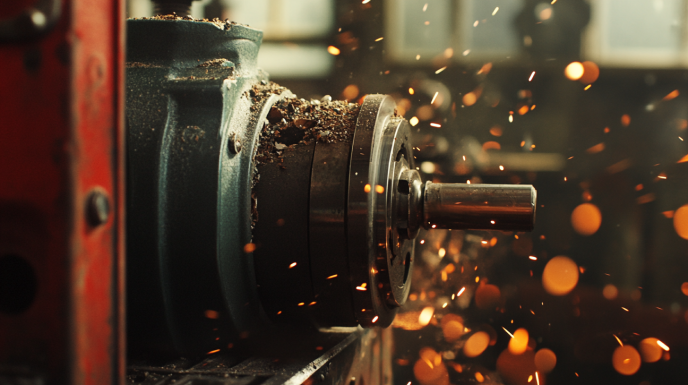
BAUER 20V Brushless Cordless, 4-1/2 in. Slide Switch Angle Grinder – Tool Only
- Powerful 20V brushless motor delivers up to 10,500 RPM
- Slide switch with lock-on for improved control, comfort, and use
- Tool-free adjustable guard for quick and easy adjustments

BAUER 6 in. Bench Grinder with LED Lights
- Powerful 2.1 Amp, 1/3 HP motor provides reliable operation that won’t bog down
- 3450 RPM max for high speed material removal
- Dual 6 in. aluminum-oxide grinding wheels for grinding, sharpening, deburring, polishing and cleaning

BAUER 7 Amp, 4-1/2 in. Slide-Switch Angle Grinder
- Powerful 7 amp motor delivers up to 11,000 RPM
- Slide switch locks grinder on and easily switches off
- Tool-free adjustable 4-1/2 in. Type 27 guard for quick, easy positioning
Transforming DIY Projects with Affordable Professional-Grade Power
In the world of power tools, finding that perfect balance between performance, durability, and affordability often feels like chasing a unicorn. Yet somehow, the Bauer grinder has managed to crack this seemingly impossible code, delivering professional-grade performance that won’t require a second mortgage on your home. As a passionate DIYer who’s burned through more tools than I care to admit, discovering the Bauer grinder was like finding hidden treasure in my local Harbor Freight. Let me take you through everything you need to know about this workshop essential that’s quickly becoming the talk of the tool community.
The Origin Story: What Exactly Is a Bauer Grinder?
The Bauer grinder isn’t just another power tool—it’s a versatile workhorse that belongs to Harbor Freight’s premium Bauer line. These angle grinders are designed for cutting, grinding, polishing, and sharpening various materials, from metal to masonry. What sets them apart is their robust construction coupled with a surprisingly accessible price point.
When I first picked up a Bauer grinder, I was immediately struck by its solid feel. Unlike some budget tools that feel like they might disintegrate at the first sign of serious work, the Bauer has a substantial weight and balance that inspires confidence. The ergonomic grip design means you can work longer without the hand fatigue that plagues users of lesser grinders.
Available in both corded and cordless variants, the Bauer grinder family offers solutions for every workspace scenario. The corded models deliver consistent, uninterrupted power for those marathon project sessions, while the cordless options provide the freedom to move around without wrestling with extension cords or hunting for outlets.
Breaking Down the Cost: Is the Bauer Grinder a Bargain or a Budget Buster?
Let’s talk dollars and sense. One of the most frequent questions that comes up is about cost, and rightfully so. In a market where professional-grade angle grinders can easily command $150-200, the Bauer grinder stands out with its remarkably competitive pricing structure, typically ranging from $39.99 to $89.99 depending on the model and whether you’re going corded or cordless.
The 4-1/2″ corded angle grinder (the most popular model) usually retails around $39.99, making it an absolute steal compared to competitors with similar specifications. The 20V cordless version comes in at approximately $69.99 for the tool only, or $89.99 with a battery and charger included.
What’s truly impressive is that this pricing doesn’t reflect a bargain-basement tool. The construction quality, motor performance, and overall durability suggest a tool that should cost considerably more. I’ve had friends in professional trades pick up my Bauer grinder and express genuine shock when I tell them what I paid for it.
When you factor in Harbor Freight’s frequent coupon offerings and sales events, you can sometimes snag these grinders at even more attractive price points. I managed to grab my cordless model during a holiday sale for nearly 20% off the regular price—a deal that still makes me smile every time I fire it up.
Where to Find Your New Workshop Companion
If you’re sold on adding a Bauer grinder to your arsenal, you’re probably wondering where to get your hands on one. The primary retailer for all Bauer tools, including their grinders, is Harbor Freight. With over 1,000 stores nationwide, there’s likely a location within reasonable driving distance for most Americans.
I personally prefer visiting the physical stores when possible. There’s something satisfying about handling a tool before purchasing, and the staff at my local Harbor Freight have always been surprisingly knowledgeable about the specifics of different models. Plus, you get to take your new tool home immediately—no waiting for shipping when you’re itching to start a project.
That said, if you’re not near a store or prefer online shopping, Harbor Freight’s website offers the complete Bauer lineup with detailed specifications and user reviews. They regularly offer free shipping on orders over a certain amount, which can make online purchasing even more attractive.
Occasionally, you might find Bauer grinders on third-party marketplaces like eBay or Amazon, but I’d recommend sticking with the official Harbor Freight channels to ensure you’re getting an authentic product with full warranty coverage.
Corded vs. Cordless: The Power Delivery Dilemma
One of the most significant decisions you’ll face when selecting a Bauer grinder is whether to go corded or cordless. Each option has distinct advantages that might make it the perfect choice depending on your specific needs.
The corded Bauer angle grinder packs a robust 7.5-amp motor that delivers consistent power regardless of how long you work. There’s no battery to run down in the middle of a project, no charging to plan, and typically a bit more torque for those demanding cutting and grinding tasks. For around $39.99, the corded model represents exceptional value, especially for users who work primarily in a fixed location with reliable power access.
On the flip side, the 20V cordless Bauer grinder offers the ultimate in convenience and portability. Imagine grinding or cutting metal in remote locations, at heights on scaffolding, or simply moving around a large workspace without constantly repositioning extension cords. The freedom is genuinely liberating. The cordless model uses Bauer’s 20V interchangeable battery system, meaning you can swap batteries between various Bauer tools—a significant advantage if you’re already invested in the ecosystem.
In my experience, the cordless Bauer grinder delivers approximately 85-90% of the corded version’s power, which is more than sufficient for most applications. The only time I’ve noticed the difference is during prolonged heavy-duty cutting of thick materials, where the corded version maintains peak performance longer.
Power Under the Hood: Understanding the Bauer Grinder’s Specifications
Numbers and specifications might make some people’s eyes glaze over, but they’re crucial when evaluating any power tool. The Bauer grinder line offers impressive specs that help explain their growing popularity among serious DIYers and professionals alike.
The corded Bauer angle grinder features a 7.5-amp motor that generates up to 11,000 RPM (no-load speed), providing ample power for cutting through metal, grinding welds, removing rust, and polishing surfaces. This power rating puts it on par with professional-grade models costing twice as much.
The cordless variant operates on Bauer’s 20V lithium-ion battery platform and delivers up to 10,000 RPM. While slightly less than its corded sibling, this is still impressive for a battery-powered tool and more than sufficient for most applications. A fully charged 4.0Ah battery typically provides 20-30 minutes of continuous use, though actual runtime varies significantly based on the intensity of your work.
Both models feature a standard 5/8″-11 spindle thread, making them compatible with a wide range of industry-standard accessories. The tool-free guard adjustment is a thoughtful addition that allows for quick repositioning as you move between tasks.
Versatility Champion: Compatible Blades and Discs
One of the Bauer grinder’s greatest strengths is its remarkable versatility, largely thanks to its compatibility with an extensive range of accessories. The standard 4-1/2″ disc size (with some models available in 5″ versions) accepts virtually every type of cutting and grinding accessory on the market.
For cutting applications, the Bauer grinder works seamlessly with:
- Metal cutting discs for ferrous and non-ferrous metals
- Diamond blades for masonry, tile, and concrete
- Abrasive cutoff wheels for general-purpose cutting
When it comes to grinding and surface preparation, your options include:
- Grinding wheels for metal removal and weld preparation
- Flap discs in various grits for smoothing and finishing
- Wire cup brushes for rust and paint removal
- Diamond cup wheels for concrete grinding
For finishing work, consider:
- Polishing pads for metal and stone
- Buffing wheels for bringing surfaces to a high shine
- Sanding discs for wood and metal surface preparation
I’ve personally used my Bauer grinder with everything from standard metal cutting discs to specialized diamond wheels for granite, and it’s handled them all admirably. The ability to quickly switch between such diverse accessories makes this tool incredibly versatile—I’ve used it for everything from cutting rebar for garden stakes to removing old grout in my bathroom renovation.
Safety First: Using Your Bauer Grinder Without Incident
Power tools demand respect, and angle grinders in particular can be dangerous if misused. Having witnessed a close call when a friend’s cheap grinder kicked back unexpectedly, I can’t stress enough the importance of using the Bauer grinder safely.
The Bauer models include several important safety features, including a two-stage trigger that prevents accidental activation, a quick-adjust safety guard, and an anti-vibration side handle that significantly improves control. These features provide a solid foundation, but safe operation still relies heavily on proper technique and precautions.
Always wear appropriate personal protective equipment when operating your Bauer grinder. At minimum, this means:
- Safety glasses or a full face shield to protect against flying particles
- Ear protection to guard against the high-decibel operation
- Heavy-duty gloves to protect your hands
- Long sleeves and pants to shield your skin from sparks
- A dust mask or respirator when cutting materials that produce hazardous dust
Beyond personal protection, proper technique is crucial:
- Always maintain a firm grip with both hands
- Position yourself so that sparks and debris fly away from your body
- Never remove the safety guard
- Allow the grinder to reach full speed before contacting the workpiece
- Let the tool do the work—applying excessive pressure increases the risk of kickback
- Ensure your workpiece is securely clamped or held
- Never use damaged or worn discs
The owner’s manual provides comprehensive safety guidelines, and I strongly recommend reviewing it thoroughly before first use, even if you’re experienced with similar tools. The few minutes spent reading could save you from a painful injury.
Metal Mastery: Cutting Through the Tough Stuff
One of the most common applications for angle grinders is cutting metal, and the Bauer grinder excels in this domain. Whether you’re cutting rebar, sheet metal, angle iron, or even stainless steel, the Bauer’s powerful motor makes short work of these materials.
For optimal results when cutting metal with your Bauer grinder:
- Select the appropriate cutting disc for your specific metal type
- Secure your workpiece in a vise or with clamps to prevent movement
- Mark your cutting line clearly
- Position the guard to direct sparks away from you
- Hold the grinder at a slight angle to the work surface (about 15-20 degrees)
- Apply gentle, consistent pressure and let the disc do the cutting
I’ve used my Bauer grinder to cut through 1/2″ steel rods, trim sheet metal for custom automotive repairs, and even fabricate brackets from angle iron. The results have been consistently impressive, with clean cuts and minimal binding or stalling.
For thicker materials, making multiple passes gradually increasing depth works better than trying to force through in a single cut. This technique extends disc life and reduces the strain on the motor. It’s worth noting that while the corded Bauer grinder has slight edge for heavy-duty metal cutting, the cordless version handles most moderate metal cutting tasks without issue.
Heavy-Duty Performance: Can the Bauer Handle Serious Projects?
This question comes up frequently, especially from professionals considering the Bauer as a budget-friendly alternative to premium brands. After two years of pushing my Bauer grinders to their limits, I can confidently say they’re surprisingly capable of handling heavy-duty applications, with a few caveats.
The corded Bauer grinder truly shines in demanding situations. I’ve used it for extended sessions cutting concrete pavers for a patio project, grinding welds on a steel gate, and even cutting through cast iron pipe during a plumbing emergency. Throughout these challenges, it maintained consistent power without overheating or showing signs of strain.
The cordless model, while slightly less powerful, still impresses with its ability to tackle serious work. During a recent off-grid cabin project, my cordless Bauer was the only power tool available for cutting metal roofing panels and grinding structural connections. With a couple of spare batteries in rotation, it handled a full day’s work admirably.
Where the Bauer grinders do show their price point is in continuous heavy-duty industrial applications. If you’re planning to use a grinder 8 hours daily in a fabrication shop or construction site, a premium professional model might offer better longevity. However, for weekend warriors, serious DIYers, and even professionals who need a reliable backup, the Bauer delivers surprising performance that belies its modest price tag.
Size Matters: Understanding Disc Dimensions
The Bauer grinder line primarily features 4-1/2″ disc models, which has become the de facto standard size for general-purpose angle grinders. This dimension refers to the diameter of the cutting or grinding disc that the tool accepts.
The 4-1/2″ size hits a sweet spot of versatility, power, and control. It’s large enough to make meaningful progress on substantial workpieces yet small enough to remain maneuverable in tight spaces. This size also represents the most widely available option for accessories, meaning you’ll never struggle to find replacement discs or specialized attachments.
Harbor Freight does occasionally offer 5″ Bauer grinder models, which provide a slightly larger cutting capacity at the expense of a bit more weight and slightly reduced maneuverability. The difference is modest but can be meaningful for specific applications like cutting deeper materials or covering more surface area when grinding.
When selecting your Bauer grinder, consider the primary materials and projects you’ll be tackling. For general-purpose use, the 4-1/2″ model offers the best balance of versatility, control, and accessory availability. If you frequently work with larger materials or need slightly deeper cuts, the 5″ variant might be worth considering.
Brand Showdown: How Does the Bauer Grinder Compare to Competitors?
The power tool market is crowded with options across every price point, so how does the Bauer grinder stack up against established competitors? Having previously owned grinders from DeWalt, Makita, and even Harbor Freight’s more budget-oriented Chicago Electric line, I can offer some perspective.
When compared to premium brands like DeWalt, Milwaukee, and Makita (typically priced between $99-$199 for comparable models), the Bauer grinder offers approximately 85-90% of the performance at roughly 30-40% of the cost. The primary differences I’ve noticed are:
- Slightly more refined speed control in premium brands
- Marginally lower vibration levels in higher-end models
- More robust brushes and switches in professional-grade tools
- Longer warranty periods (typically 3-5 years vs. Bauer’s 90 days standard or 2 years extended)
Against direct price competitors like Ryobi and Black & Decker, the Bauer generally outperforms with better power delivery, superior ergonomics, and more durable construction. I previously owned a Ryobi angle grinder that struggled with tasks the Bauer handles with ease.
Compared to Harbor Freight’s own budget Chicago Electric line, the Bauer represents a significant step up in quality, performance, and durability. The price difference ($39.99 vs. approximately $29.99 for the Chicago Electric) is easily justified by the superior motor, better build quality, and improved safety features.
For most users, the Bauer grinder hits an impressive sweet spot of performance and value. Unless you’re using your grinder professionally every day, the premium you’d pay for top-tier brands is difficult to justify given the Bauer’s capabilities.
Speed Controls: Fixed or Variable?
One area where the Bauer grinder line shows its position in the market is in speed control options. The standard Bauer angle grinders feature a fixed speed motor—typically operating at 11,000 RPM for the corded model and 10,000 RPM for the cordless variant. This single-speed operation is actually ideal for most cutting and heavy grinding applications, where maximum power is desired.
However, unlike some premium models that offer variable speed controls, the standard Bauer grinders don’t provide the option to dial back the RPMs for specialized tasks like polishing, where lower speeds can provide better results and prevent overheating.
Harbor Freight has occasionally offered limited-edition Bauer grinder models with variable speed functionality, but these aren’t regularly stocked items. If variable speed is crucial for your applications, you might need to consider other brands or look for these special Bauer releases.
In practice, I’ve found the fixed speed rarely presents significant limitations. For the occasional tasks where lower speeds would be beneficial, I simply use a lighter touch and take more breaks to prevent heat buildup. The money saved easily justifies this minor inconvenience for most users.
Material Mastery: What Can You Cut and Grind?
The versatility of the Bauer grinder is truly impressive when you consider the range of materials it can effectively process. With the appropriate accessories, your Bauer can handle:
- Ferrous metals (steel, iron, etc.)
- Non-ferrous metals (aluminum, copper, brass)
- Masonry (concrete, brick, block)
- Tile (ceramic, porcelain)
- Stone (granite, marble, slate)
- Fiberglass and composites
- Wood (though not ideal and requires special discs)
I’ve personally used my Bauer grinders on all these materials with excellent results. The power delivery is consistent enough to cut through 1/2″ steel plate yet controlled enough for precision work on thinner materials.
For metal applications, the Bauer excels at cutting structural steel, rebar, sheet metal, tubing, and profiles. It makes quick work of removing welds, deburring edges, and preparing surfaces for welding or finishing.
In masonry applications, paired with a quality diamond blade, the Bauer grinder cuts through concrete blocks, pavers, and brick with surprising efficiency. I recently used mine to create a curved edge on concrete pavers for a garden path, and the precision was impressive.
The only material I’ve found challenging is hardened tool steel, which can be difficult for any angle grinder without specialized cutting discs. Even then, the Bauer performs admirably when you don’t push it beyond its capabilities.
Accessories and Attachments: What’s in the Box?
The standard Bauer angle grinder package is relatively straightforward, including:
- The grinder itself
- A side handle (anti-vibration design)
- An adjustable safety guard
- A spanner wrench for disc changes
- Basic operating instructions
For the cordless models, some packages include a 20V battery and charger, while “tool-only” options assume you already have compatible batteries from other Bauer tools.
Notably absent from the standard package are any cutting or grinding discs. This is actually common practice across most brands and allows you to purchase exactly the type of disc you need for your specific application rather than being stuck with a generic option that might not be ideal.
Harbor Freight does offer Bauer accessory bundles that include assortments of cutting wheels, grinding discs, and wire brushes at attractive price points. These starter kits can be an excellent value if you’re new to angle grinders and want to experiment with different applications.
The Bauer grinder accepts all standard accessories that fit 4-1/2″ (or 5″ for those models) grinders with a 5/8″-11 arbor, meaning you’re not limited to Harbor Freight’s own accessories. I’ve used premium discs from brands like Diablo and Norton with my Bauer grinders when precision and longevity were priorities.
Warranty Coverage: Protection for Your Investment
The standard warranty on Bauer power tools, including their grinders, is 90 days. This is admittedly shorter than many competitors, who typically offer 1-3 year warranties on comparable tools. However, Harbor Freight does offer an extended 2-year replacement plan for a modest additional cost (usually around $7-10 depending on the tool’s price).
I personally always opt for the extended warranty on Bauer tools. For less than 20% of the tool’s cost, you get 8 times the warranty coverage—a value proposition that’s hard to ignore. The replacement process is straightforward and hassle-free in my experience.
It’s worth noting that even without the extended warranty, the value equation remains favorable. If a $40 Bauer grinder lasts even half as long as a $120 premium brand grinder, you could replace it twice and still come out ahead financially.
In my experience, with proper care and maintenance, Bauer grinders significantly outlast their warranty period. My oldest Bauer grinder is approaching three years of regular use with no signs of giving up.
Maintenance Matters: Keeping Your Bauer Grinder in Prime Condition
Like any power tool, proper maintenance significantly extends the life of your Bauer grinder. Fortunately, these tools require minimal upkeep to keep performing at their best.
After each use, I recommend:
- Unplugging or removing the battery
- Blowing out the ventilation ports with compressed air to remove dust (wear eye protection!)
- Wiping down the exterior with a clean cloth
- Inspecting the power cord (corded models) for any damage
- Checking the disc guard for secure attachment
- Examining the grinding disc for any cracks or excessive wear
For more thorough maintenance every few months:
- Remove the side covers (if your model allows) to clean out accumulated dust
- Check the brushes for wear (replacement brushes are available)
- Apply a light lubricant to any moving parts like the guard adjustment mechanism
- Inspect the gears for proper lubrication if you can access them
- Tighten any loose screws or fasteners
For cordless models, proper battery care is essential. Store batteries at room temperature, avoid completely discharging them, and use the manufacturer’s recommended charger. With proper care, Bauer 20V batteries can last for several years of regular use.
Beginner-Friendly: Is the Bauer Grinder Suitable for Novices?
Power tools can be intimidating for beginners, and angle grinders in particular have a reputation for being somewhat aggressive tools. However, the Bauer grinder includes several features that make it more approachable for those new to power tools.
The ergonomic handle design provides excellent grip and control, helping beginners maintain proper positioning. The two-stage power switch prevents accidental activation, a common concern for those new to powerful tools. The adjustable guard can be positioned for optimal protection without tools, making safety adjustments simple.
The reasonable weight (typically around 4-5 pounds) makes the Bauer grinder manageable for extended use without excessive fatigue, an important consideration for those still developing proper technique and tool handling skills.
Perhaps most importantly for beginners, the affordable price point reduces the financial stress of trying a new tool category. At around $40 for the corded model, the investment is low enough that newcomers can experiment without significant financial risk.
I’ve introduced several friends to angle grinders using my Bauer models, and all have commented on how much more manageable they were than expected. The combination of good balance, intuitive controls, and adequate power without being overwhelming makes the Bauer an excellent entry point into the world of angle grinders.
Sharpening Specialist: Tool Maintenance Applications
While primarily designed for cutting and grinding, the Bauer grinder can double as an effective tool sharpening station with the right accessories. This versatility adds significant value, especially for those who maintain a variety of garden tools, shop equipment, or bladed implements.
For sharpening applications, I recommend using specialized grinding wheels designed specifically for tool sharpening rather than general-purpose grinding discs. These specialized wheels typically have a finer grit and are designed to remove material more precisely without overheating the tool edge.
The Bauer grinder works well for sharpening:
- Lawn mower blades
- Garden tools like shovels, hoes, and edgers
- Chisels and scrapers
- Axes and hatchets
- Certain types of knives (though extreme care is required)
The fixed high speed of the Bauer does mean you need to use a light touch and frequent cooling when sharpening to prevent overheating the tool edge, which can damage the temper of the metal. I typically use short, gentle passes and frequently dip the tool being sharpened in water to maintain proper temperature.
While dedicated sharpening tools might offer more precision for fine cutting implements, the Bauer grinder provides a practical and economical solution for maintaining the majority of workshop and garden tools.
Replacement Parts: Extending Your Grinder’s Lifespan
One measure of a tool’s quality is the availability of replacement parts that allow for repair rather than replacement when components wear out. Harbor Freight has improved significantly in this area with their Bauer line, offering several key replacement parts for their grinders.
The most commonly replaced components include:
- Carbon brushes (which naturally wear over time)
- Power switches (which can eventually fail after numerous cycles)
- Cord assemblies for corded models
- Guard assemblies if damaged
- Gear case components
These parts can be ordered directly through Harbor Freight’s customer service or at local stores. Prices are reasonable, with brush sets typically costing under $10 and most other components priced proportionally to the tool’s overall cost.
For cordless models, replacement batteries and chargers are readily available, with multiple battery capacity options allowing you to choose between lighter weight (2.0Ah) and extended runtime (4.0Ah or 5.0Ah) depending on your needs.
The modular design of the Bauer grinder makes most common repairs relatively straightforward for those with basic technical skills. Harbor Freight also offers repair services, though given the tool’s low initial cost, extensive repairs beyond basic component replacement may not be economically justifiable.
The Verdict: Reviews and Ratings from Real Users
No tool review would be complete without considering the broader consensus among users. The Bauer grinder line has accumulated thousands of reviews across Harbor Freight’s website and various tool forums, with impressively positive overall ratings.
On Harbor Freight’s own site, the corded 4-1/2″ Bauer angle grinder consistently maintains a 4.5+ out of 5-star average rating across more than 2,000 reviews. The cordless models typically score slightly lower at around 4.3 stars, primarily due to battery life concerns rather than tool performance issues.
Professional reviewers and tool testing sites frequently express surprise at the Bauer grinder’s performance relative to its price point. Common praise focuses on power delivery, build quality, and ergonomics, while criticisms typically center on the short standard warranty and occasional quality control inconsistencies.
In my experience monitoring tool forums and social media groups, the Bauer grinder has developed something of a cult following among budget-conscious DIYers and professionals alike. Many users report years of reliable service even under demanding conditions, challenging the perception that low-cost tools necessarily sacrifice durability.
The most telling statistic might be the recommendation rate—over 90% of Bauer grinder owners indicate they would recommend the tool to others. For a product in this price range, that level of customer satisfaction speaks volumes about the value proposition these grinders offer.
Conclusion: The Final Grind
After thousands of words exploring every aspect of the Bauer grinder line, the conclusion becomes clear: these tools represent an exceptional value that challenges conventional wisdom about budget-friendly power tools. The Bauer grinder delivers professional-grade performance at entry-level pricing, making quality power tools more accessible to hobbyists, DIYers, and budget-conscious professionals alike.
Whether you opt for the corded model’s consistent power delivery or the cordless version’s liberating portability, the Bauer grinder provides the versatility, durability, and performance to tackle a vast array of cutting, grinding, and finishing tasks. The wide compatibility with standard accessories further extends its utility across countless applications.
While not without limitations—notably the shorter standard warranty and fixed speed operation—the Bauer grinder’s strengths far outweigh its weaknesses, especially when considered against its remarkable price point. The optional extended warranty addresses the primary concern, while the fixed speed rarely presents significant limitations in real-world use.
For beginners, the Bauer offers an approachable entry point into the world of angle grinders without the intimidating investment of premium brands. For experienced users, it provides capable performance that often challenges the need for more expensive alternatives except in the most demanding professional scenarios.
In a market where tool prices seem to climb ever higher, the Bauer grinder stands as proof that quality, performance, and affordability can still coexist. Whether it’s your first angle grinder or an addition to an extensive tool collection, the Bauer deserves serious consideration. Your projects—and your wallet—will thank you.

